2.6 Flea Bite Allergy – Dogs and Cats
Learning Objectives
- Describe the life cycle and living habits of the flea, and how this influences flea control methods.
- Define the pathogenesis of flea allergy dermatitis.
- What are the clinical signs of flea bite allergy in dogs and cats, and how is it treated?
- List the general principles of flea control.
- Define the specific chemicals that are contained in flea control products, the mechanism of action of each, and the possible role of each in a flea control program.
-
General Considerations
- Flea bite allergy is the most common pruritic skin disease of dogs and cats in warm climates and tropical countries.
- It arises as the result of a hypersensitivity reaction to various antigens present in the flea saliva.
- Flea bite allergy is an important disease in small and mixed animal practices. Unfortunately, it is often ineffectively managed.
- Be sure to know how to manage it!
Important Facts
- Flea bite allergy is the most common pruritic dermatosis of dogs and cats in warm and tropical climates.
- Be sure to know how to manage it!
-
Cause
- Fleas are small, brown wingless bloodsucking insects belonging to the order Siphonaptera. There are several types of fleas:
- Ctenocephalides (C) felis – most common flea of dogs and cats.
- C. canis – appears to be endangered if not extinct in USA.
- Echidnophaga (E) gallinacea – sticktight flea of poultry. It can be a problem in southeast US – March, April, October, and November.
- Pulex irritans – human flea. It may be found on dogs in the southeastern US.
- C. felis, C. canis and E. gallinacea may also parasitize man under the right conditions; i.e. if no dogs or cats are around!
- Fleas are small, brown wingless bloodsucking insects belonging to the order Siphonaptera. There are several types of fleas:
Important Facts
- Ctenocephalides felis is the most common flea of dogs and cats.
-
- Life Cycle:
- The stages of the life cycle are eggs —- 3 larval stages —- pupa —- adult.
- The length of the life cycle depends on environmental conditions.
- The entire life cycle usually takes 3 to 4 weeks.
- It can be completed in as little as 12 to 14 days.
- It can take as long as 6 months.
- Optimum conditions are 65°F to 80°F, with high humidity.
- Fleas do not live at altitudes over 5000 ft.
- Adult fleas spend most of their time on the pet. Once they hatch, they must find a host within 1 to 2 weeks (adult C. felis are permanent ectoparasites). Actively feeding cat fleas removed from their host do not survive longer than 3 to 4 days.
- However, adult fleas only represent about 1% of the total infestation!
- The biggest problem with fleas is massive environmental contamination with eggs, larvae and pupae, not the adults on pets!
- Female fleas can produce up to 40 to 50 eggs per day (average 27/day).
- Female fleas can lay over 2000 eggs during their life.
- No life cycle stage can survive freezing (10 days at 3°C or 5 days at 1°C).
- Adult fleas may survive over the winter by “hitchhiking” on wild animals (raccoons, opossums).
- The female Echidnophaga gallinacea flea burrows into the host’s skin to lay eggs. Larvae drop off the skin into the environment.
- Life Cycle:
Important Facts
- Actively feeding Ctenocephalides felis will not survive outside the host for longer than 3 to 4 days. It is a permanent ectoparasite.
- The biggest problem with fleas is massive environmental contamination with eggs, larvae and pupae.
- Optimum environmental conditions are 65°F to 80°F and high humidity.
-
Pathogenesis
- When fleas bite, their mouthparts release saliva, which contains anticoagulants and pruritogenic enzymes. This accounts for the immediate itch associated with the bite.
- Some of the salivary components are antigenic and evoke a type I and IV hypersensitivity response in the host, which are responsible for the majority of the clinical signs.
- Flea Antigen:
- Flea saliva contains multiple (at least 15) substances to which dogs and cats develop sensitivity. The pattern of sensitivity (which substances the animal is sensitive to) appears to vary substantially between individuals.
- The Host Hypersensitivity Response to Fleas:
- Involves several different types of immunity. Any one type or any combination of types may be present depending on the animal.
- Classical type I (immediate, IgE-mediated) and type IV (delayed-type, cell-mediated).
- Most dogs have both.
- 30% have only delayed.
- Late onset IgE-mediated response.
- Cutaneous basophil hypersensitivity.
- The hypersensitivity state is maintained for years.
- Nonreactivity to flea bites involves immunologic tolerance.
- Dogs and cats do not achieve natural desensitization to flea antigens.
- Factors which favor the development of flea allergy:
- Intermittent exposure to fleas.
- First exposure to fleas later in life.
- Dogs with atopic dermatitis.
Important Facts
- Most flea allergic dogs and cats develop a type I (immediate, IgE mediated) and type IV (delayed, cell mediated) hypersensitivity to multiple antigens present in the flea saliva.
- Intermittent exposure to fleas, first exposure to fleas later in life, and atopic dermatitis are factors that predispose animals to the development of flea allergy.
-
Clinical Signs
- Dogs:
- They are pruritic!
- The distribution of lesions is very typical and should increase the clinician’s index of suspicion for FBA:
- Dorsal lumbar-sacral area, base of the tail, medial and caudal hind limbs, abdomen, inguinal area and inner thighs. It may generalize.
- Dogs:
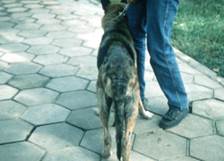
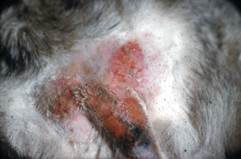
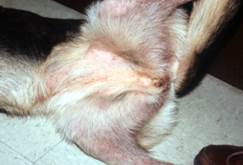
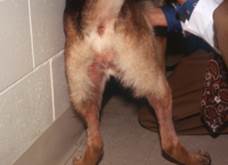
-
-
- What lesions do we see?
- Papular eruption. In contrast to canine atopic dermatitis where papules develop later due to secondary superficial pyoderma, in FBA papules are formed initially as a result of the allergic response.
- Crusting, excoriation, scaling, self-inflicted alopecia, lichenification (sign of chronic inflammation), hyperpigmentation (sign of chronic inflammation), acute moist pyotraumatic dermatitis (i.e. “hot spot”).
- Secondary pyoderma – papules, pustules, crusts, epidermal collarettes.
- Secondary seborrhea – scaling with or without excess oil.
- Any age. However, the most common age of onset range from 3 to 5 years.
- What lesions do we see?
- Cats:
- They are pruritic too!
- Where are they pruritic?
- Lesion distribution is similar to dogs. Lumbar-sacral area, base of the tail, caudal aspects of hind legs and medial thighs. It can extend to the neck.
- What lesions do we see?
- Crusted papules – “miliary dermatitis”. Flea bite allergic dermatitis is the most common cause of miliary dermatitis in cats.
- Self-inflicted hair loss and excoriations.
-
Important Facts
- Clinical signs of flea bite allergy are very typical!
- Dogs and cats will develop self-inflicted alopecia, papules and crusts localized to the lumbar-sacral region, base of the tail, caudal aspects of hind legs, medial thighs, abdomen and groin. Caudal aspect of the body!
- In cats, the papule-crust lesions are called “miliary dermatitis”, and flea bite allergy is the most common cause of this clinical sign in cats.
- Pruritus is always present and it is often severe!
-
Diagnosis
- The diagnosis is made based on a characteristic history and clinical signs, as distribution of lesions and pruritus is nearly pathognomonic, especially if fleas and/or flea feces is found.
- Examine the animal carefully for fleas and flea feces. Always use a flea comb to do this! Feces appear as small, dry, black, often comma-shaped specks that release a reddish-brown color when placed on moistened white paper.

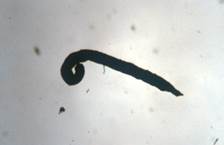
-
- Fleas and/or flea feces are often, though not always, evident on the affected animal. Therefore, absence of fleas or flea feces does not rule out flea bite allergy. They are often in small amounts in affected animals because they ingest or remove them during itching.
- Intradermal testing is a way to demonstrate IgE antibodies to flea antigens. However, not all animals will have a positive immediate reaction because of the multiple types of hypersensitivity involved but most will.
- The intradermal test can be used as an aid to client compliance and not as a diagnostic test.
Important Facts
- Diagnosis is based on a characteristic history and clinical signs.
- The presence of fleas and/or flea feces strongly supports the diagnosis, however, do not rule out flea bite allergy if you don’t find fleas and/or flea feces on the affected animal!
-
Treatment
- General Principles of Treatment:
- CLIENT EDUCATION is the single most important factor in successful treatment of flea bite allergy.
- Increase client’s awareness of the pathogenesis – they must realize that even one flea can induce clinical signs on an allergic dog or cat!
- Increase client’s knowledge of flea control measures.
- Make clients aware of important factors in flea control:
- Largest numbers of eggs are found where the pet spends most of its time.
- Larva will migrate under furniture.
- Pupal stage is difficult to kill and results in continued emergence of fleas (“pupal window effect” – new adult fleas are seen 3 to 4 weeks after treating the environment).
- Preventive flea control is more successful than waiting until a flea population is established.
- Inhibiting development of larva with insect growth regulators is essential to a successful flea control program.
- Compliance is critical!
- General procedures that must be followed:
- Eliminate ALL fleas in the environment.
- Provide treatment to control secondary problems such as pyoderma, seborrhea, or pyotraumatic dermatitis.
- In many cases, brief courses of oral corticosteroids or oclacitinib (Apoquel®) are used to suppress the allergic response and provide immediate comfort while fleas are eliminated from the pet and environment. Symptoms of flea bite allergy can persist for days after the last flea is killed.
- The traditional “three-pronged” approach:
- Treat the house.
- Treat the yard.
- Treat ALL pets in the household.
- Ideally use a combination of an adulticide chemical (to kill existing fleas) and an insect growth regulator (to interrupt the life cycle thus preventing a continuous new crop of adults).
- Flea control must be individualized to each client to an extent. It is extremely helpful and timesaving to design a client education sheet for your practice. Train your receptionists and technicians to answer common questions.
- Attempts to use immunotherapy (hyposensitization) with flea extracts have been unsuccessful to date. Newer “hi-tech” approaches to produce recombinant flea allergen, etc. may hold promise in the future.
- Corticosteroid or oclacitinib (Apoquel®) use in flea bite allergy:
- Use as a temporary measure only while flea control is underway.
- Prednisolone 0.5 mg/kg orally once or twice daily for 4 to 7 days, then the same dose every-other-day for 10 days should suffice. Alternatively, Apoquel® at 0.4-0.6 mg/kg orally twice daily for 14 days can also be helpful.
- If the pruritus recurs after discontinuing the oral prednisolone or Apoquel®, it is likely that the flea control was not 100% efficacious.
- There is no justification for repeated use of injectable long-acting corticosteroids to control flea bite allergy since such use may lead to iatrogenic hyperadrenocorticism and diabetes mellitus, especially in cats. Moreover, oral glucocorticoids work as well, if not better, and are safer.
- CLIENT EDUCATION is the single most important factor in successful treatment of flea bite allergy.
- General Principles of Treatment:
-
Treatment: Specifics of flea control
- Two options: Move to a flea free geographic region or engage in a chemical warfare.
- Many products are on the market but several are ineffective in areas where fleas are an important issue.
- Read labels for ingredients. You only need a limited number of products but know how to use them properly.
- How to select products for individual clients – consider:
- Efficacy – must kill fleas! Fleas have long become resistant to most “grocery store” products.
- Safety – to owner and pet.
- Convenience of application and owner preferences.
- Cost.
- Species of pets and ages.
- Environment – are pets indoors, outdoors, both? Fenced yard, city apartment, or many acres?
- Geographic area: warmer climate = worse problems.
- Chemicals used: Adulticides – the use of products containing carbamates and organophosphates on pets is decreasing significantly with the advent of safer products. These products will not be discussed here.
- Pyrethrins/Pyrethroids:
- Pyrethrins are generally considered safe even for very young animals. Rapid metabolism by mammals but insects are unable to detoxify. They break down very fast in the environment. They are present in many flea products.
- Pyrethrins have very rapid insecticidal activity but virtually no residual effect.
- Pyrethroids have greater stability and residual action but also increased mammalian toxicity. Example: permethrin.
- Cats are sensitive to the toxicity of pyrethroids because their liver is inefficient at glucuronide conjugations. Permethrins can only be safe for cats at concentrations of 0.05% to 0.1%. Clinical signs of toxicity include ear flicking, muscle tremors, vomiting, anorexia, seizures and death.
- Permethrin can kill adult fleas and larvae.
- Generally contain a synergist (piperonyl butoxide or one of the “MGK” –series).
- Imidacloprid + pyriproxyfen [Advantage II®]; + moxidectin [Advantage Multi®], + pyriproxyfen + permethrin [K9 Advantix II®]).
- Imidacloprid constitutes a class of insecticides termed either “heterocyclic nitromethylenes” or “chloronicotinyl nitroguanidines”.
- It is not a cholinesterase inhibitor. It has very low mammalian toxicity. Used in dogs and cats.
- Mechanism of action: binds to insect postsynaptic nicotinergic acetylcholine (Ach) receptors preventing acetylcholine from binding. This prevents transmission of impulses resulting in death of the insect. Some insects (e.g. fleas) have many of these receptors and the receptors are important. Other creatures (e.g. ticks) have few, so the compound is not effective against ticks. Mammalian nicotinergic receptors are not as numerous or are of different function, so that the compounds are of relatively low toxicity in mammalians. Pyriproxyfen is an insect growth regulator and by mimicking the insect Juvenile Hormone, it inhibits the insect development to an adult phase.
- Products are supplied as a spot-on formula. Apply to the dorsum; it spreads in the sebum layer. The effect lasts for 4 weeks. Rain and wetting may reduce efficacy.
- Do not use permethrin products on a dog if there is a cat in the house that may groom the dog.
- Fipronil [Frontline® (dogs and cats), Parastar® (dogs) and EasySpot® (cats) ]. A phenylpyrazole (class of insecticides).
- Fipronil is not a cholinesterase inhibitor. It has very low mammalian toxicity. Used in dogs and cats. Kill both fleas and ticks.
- Mechanism of action: interferes with GABA and glutamate- regulated chloride channels in the nervous system by preventing the flux of chloride ions into the nerve cell resulting in hyperexcitation of the insect nervous system.
- Supplied as a spray in which case the product needs to be thoroughly applied throughout the body until the coat is wet (almost like a rinse). Also supplied as a spot on formulation.
- Long residual effect – it lasts 4 to 8 weeks even with shampooing (the product concentrates in the hair follicles and continually “reapplies” as sebum is secreted). However, avoid shampooing 24 hours or longer after application if using degreasing products such as, benzoyl peroxide shampoos.
- Fipronil + (S)-methoprene (Frontline Plus®) and with pyriproxyfen (Frontline Gold®):
- It may shorten the time required to eliminate a flea infestation by both killing adults and preventing the development of eggs and larvae with the same product. Methoprene and pyriproxyfen are insect growth regulators and interrupt the flea life cycle.
- Selamectin (Revolution®). It is an avermectin endectocide (has activity against ectoparasites and endoparasites), manufactured to be applied topically (spot-on).
- It modulates neurotransmission via glutamate-gated chloride channels. Similar to ivermectin it potentiates the action of GABA, which will then open the postsynaptic chloride channels allowing the influx of negatively charged chloride ions and the induction of resting potential.
- It is indicated for the prevention and control of flea infestations (kills adult fleas and prevents flea eggs from hatching).
- It should be applied once a month. Start one month before the fleas become active.
- Insecticidal activity may be slower than fipronil and imidacloprid but residual effect is good especially in cats.
- Selamectin is not very effective for ticks.
- Bathing or shampooing the animal 2 or more hours after treatment will not reduce the efficacy of Revolution.
- Nitenpyran (Capstar®):
- It is a neonicotinoid similar to imidacloprid.
- It is a systemic adulticide.
- It has very rapid insecticidal effect: 90% of fleas are eliminated within 4-6 hours after treatment.
- There is no residual activity.
- It is an oral medication and it should be given at the dosage of 1 mg/kg once daily.
- The utility of this drug is for the short-term effect of complete and relatively rapid elimination of fleas on infested pets.
- Dinotefuran + permethrin + pyriproxyfen (Vectra 3D®, Summit VetPharm). Labeled for dogs
- Dinotefuran is a third generation member of the neonicotinoid class of insecticides. It binds to nicotinic receptors in the nerve synapse, resulting in continuous nerve stimulation culminating with death of the insect. Permethrin works as a repellent and pyriproxyfen is an insect growth regulator (see below).
- It should be applied to the shoulder blade area once a month. It can be used safely in puppies older than 7 weeks.
- It kills 96% of the fleas in 6 hours. It also has an effect against eggs, larvae and pupae due to the pyriproxyfen action.
- Do not use this product if there is a cat in the house that may groom the dog.
- Spinosad [Comfortis® (Lilly), Trifexis® (+ milbemycin oxime) Elanco]– Labeled for dogs
- Spinosad targets binding sites on nicotinic acetylcholine receptors leading to activation of this receptor and disruption of acetylcholine transmission.
- Comfortis® or Trifexis® is given orally once a month at the minimum dosage of 13.5mg/lb (30mg/kg) of spinosad and 0.2 mg/lb (0.5 mg/kg) of milbemycin oxime. Giving with food may potentiate absorption.
- Adverse effects were anecdotally reported when Comfortis® was used in conjunction with high doses of ivermectin used to treat demodicosis. Side effects included ataxia, salivation, lethargy, dilated pupils and isolated seizures. Do not use this product in conjunction with extra-label doses of ivermectin.
- Trifexis®, which contains mylbemycin oxime, also prevents heartworm disease and controls intestinal parasites.
- Spinetoram (Cheristin®, Assurity® for cats , Elanco) – Labeled for cats
- Spinetoram activates the nicotinic acetylcholine receptors causing the death of fleas. The manufacturer claims that Assurity® starts working within 30 minutes and kills 98% to 100% of fleas within 12 hours.
- The manufacturer recommends applying the tube content topically to the skin at the base of the cat’s neck once monthly. Refer to the package insert for more details. Do not use on kittens less than 8 weeks of age.
- Indoxacarb (Activyl®, Merk) – Spot-on labeled for dogs, cats, puppies and kittens 8 weeks or older
- After application, it penetrates the flea by ingestion or contact and is converted by flea enzymes to an active metabolite that is highly insecticidal.
- The manufacture claims that indoxacarb is not only an adulticide but also interrupts the flea life cycle by inhibiting the development of the flea larvae.
- The manufacturer recommends applying the entire tube content topically to two evenly divided areas along dog’s back (e.g. shoulder blade and base of tail) once monthly.
- Activyl® Tick Plus: contains permethrin in addition to indoxacarb and provides tick repellence against Dermacentor variabilis and Rhipicephalus sanguineus for 4 weeks. Effect against Dermacentor variabilis was noted 2 hours after application. THIS PRODUCT CANNOT BE USED IN CATS AS IT CONTAINS PERMETHRIN!
- Imidacloprid + flumethrin (Seresto®, Bayer): Collar labeled for dogs, cats, puppies and kittens.
- It kills fleas and repels and kills ticks for up to 8 months.
- It is water-resistant and odorless.
- Fluralaner (Bravecto®, Merk Animal Health): Flavored chews for dogs 6 months of age or older. Topical spot-on for cats age 6 months or older.
- It belongs to the isoxazoline class of ectoparasiticides. Fluralaner blocks the GABA – gated chloride channels causing hyperexcitation and death of insects and acarines.
- It kills fleas and ticks for 3 months (Amblyoma americanum for 2 months) and should be administered with food.
- The chewable tablets are flavored with pork and cannot be used in dogs undergoing a food elimination trial.
- Isoxozalines have been reported to induce neurologic signs (e.g. tremors, ataxia, seizures) and should be used with caution especially in dogs with a history of seizures.
- Afoxolanar (NextGard®, Merial): Flavored chews for dogs 2 months of age or older.
- It belongs to the isoxazoline class of ectoparasiticides. Afoxolanar blocks the GABA – gated chloride channels causing hyperexcitation and death of insects and acarines.
- It kills fleas and ticks for 30 days and can be administered with or without food.
- The chewable tablets are beef-flavored and should not be used in dogs undergoing a food elimination trial.
- Isoxozalines have been reported to induce neurologic signs (e.g. tremors, ataxia, seizures) and should be used with caution especially in dogs with a history of seizures.
- Sarolaner (Simparica®, Zoetis): Flavored chews for dogs 6 months of age or older.
- It belongs to the isoxazoline class of ectoparasiticides. Sarolaner blocks the GABA – gated chloride channels causing hyperexcitation and death of insects and acarines.
- It kills fleas and ticks for 30 days and can be administered with or without food.
- The chewable tablet is flavored and should not be used in dogs undergoing a food elimination trial.
- Isoxozalines have been reported to induce neurologic signs (e.g. tremors, ataxia, seizures) and should be used with caution especially in dogs with a history of seizures.
- Lotilaner (Credelio®, Elanco): Flavored chewable tablets for dogs 2 months of age or older.
- It belongs to the isoxazoline class of ectoparasiticides. Lotilaner blocks the GABA – gated chloride channels causing hyperexcitation and death of insects and acarines.
- It kills fleas and ticks for 30 days and must be administered with a meal or within 30 minutes after feeding.
- The chewable tablets are beef-flavored and should not be used in dogs undergoing a food elimination trial.
- Isoxozalines have been reported to induce neurologic signs (e.g. tremors, ataxia, seizures) and should be used with caution especially in dogs with a history of seizures.
- Pyrethrins/Pyrethroids:
- Chemicals used: Insect Growth Regulators (IGRs)
- Juvenile Hormone Analogues:
- They are compounds that mimic insect juvenile hormones.
- When IGRs are used, insects are “overloaded” with juvenile hormone, preventing the larvae from pupating.
- Ovicidal.
- No effect on adult fleas or developing pupae!
- Virtually nontoxic to mammals.
- Long residual action – months.
- Examples: Methoprene (Precor® – methoprene is sensitive to UV light and it has little value outdoors) and pyriproxifen (Nylar® – newest, most potent and UV light stable).
- Juvenile Hormone Analogues:
- Chitin Synthesis Inhibitors (Insect Development Inhibitors [IDIs]):
- Inhibit development of chitin exoskeleton and “egg tooth” of flea during all immature stages of life cycle.
- Lufenuron (Program®) – currently the only licensed product in the USA.
- Low oral toxicity in cats and dogs. Long residual action (stored in adipose tissue and released slowly into bloodstream).
- Adult fleas that bite dogs or cats are not killed but become sterile.
- Adult fleas also excrete feces containing lufenuron, which is food for larvae. Larvae die out when ingest feces containing lufenuron.
- A remaining potential problem: fleas still have to bite dog to ingest it!
- Repellents – very limited efficacy!
- Brewer’s yeast – ineffective orally.
- Pennyroyal, eucalyptus, garlic – not effective.
- Ultrasonic room devices or collars – unproved efficacy.
- Avon Skin-So-Soft bath oil – an effective repellent (1/5 once per gallon of water, can be mixed with flea dip).
- The Three Most Common Reasons for Failure of Flea Control.
- Failure to treat environment adequately
- The inside premises – very important!
- Mechanical control procedures in infested environments.
- Wash pet’s bedding.
- Vacuum thoroughly – dispose of bag. “Sciences Daily” – January 2008, commented on a study conducted at the Ohio State University showing that vacuuming kills 96% of adult fleas and 100% of larvae and pupae stages. C. felis fleas were placed on a tightly woven kitchen -type of carpet. The investigators believed that the fleas were killed due to damaging effects of the brushes, fans and powerful air currents in vacuum cleaners.
- Steam-clean carpets.
- Use sprays or exterminator with IGR such as methoprene (Precor®), pyriproxifen, or 2-[1-Methyl-2-(4-phenoxyphenoxy) ethoxy] pyrIdine (Nylar®) and an adulticide.
- Treat twice at 2-week intervals and then every 2 months during flea season.
- Start next year one month before season starts and then treat every 2 months as before. May only need IGR.
- Sodium polyborate brushed into carpet is another alternative.
- Mechanical control procedures in infested environments.
- The yard.
- Spray with malathion, chlorpyrifos, microencapsulated diazinon or pyrethrins + nylar every 2 to 4 weeks during season.
- Concentrate on areas protected from direct sunlight.
- Steinernema carpocapsae: nematode that infects flea larvae. It is a non-chemical alternative.
- Keep in mind that those very hot dry summers or very wet times may decrease the outside flea burden.
- The inside premises – very important!
- Poor selection of products.
- Use of chemicals to which fleas are resistant.
- Use of chemicals with poor residual effects.
- Failure to use combination of adulticide and IGR.
- Failure to treat all animals in contact with household.
- Failure to treat environment adequately
- Cats require some special considerations:
- Cats do not like baths.
- Cats are very sensitive to organophosphate toxicity.
- Cats are very sensitive to products containing permethrin at concentrations higher than 0.1%
- Cats salivate profusely when alcohol-based products are used.
- Recommendations for cats:
- Bravecto® (fluralaner topical solution) for cats
- Revolution Plus® (selamectin and sarolaner topical solution)
- Frontline®
- Revolution®
- Advantage®
- Program®
- Capstar®
- Assurity®
- Nylar® flea collars
Important Facts
- Client compliance is critical for success of the prescribed treatment regimen, so be sure to educate your client well!
- Clients have to realize that even one flea can induce clinical signs on an allergic animal. Therefore, it is necessary to eliminate ALL fleas in the environment and on the animal(s)!
- For success, it is important to treat the house, treat the yard and treat all animals in the household.
- Aim to use a combination of an adulticide chemical to kill existing fleas and an insect growth regulator to interrupt the life cycle thus preventing a continuous new crop of adults.
- Flea control must be individualized for each client to an extent.
- Provide treatment to control secondary problems such as pyoderma, seborrhea, or pyotraumatic dermatitis.
- In many cases, brief courses of oral corticosteroids or oclacitinib (Apoquel®) are used to suppress the allergic response and provide immediate comfort until fleas are completed removed from the environment and animals.
- Allergen-specific immunotherapy using flea extracts has been unsuccessful to this date.
References
Blagburn BL, Dryden MW. Biology and treatment, and control of flea and tick infestations. Vet Clin Small Anim 2009; 39:1173-1200.
Datz C. Isoxazolines. Clinician’s Brief, April 2018.
Halos F, Beugnet F, Cardoso L et al. Flea control failures? Myths and realities. Trends Parasitol 2014; 30:228-233.
Miller, Griffin, Campbell. Muller and Kirk’s Small Animal Dermatology. 7th Edition. In: Hypersensitivity Disorders. Elsevier Health Sciences. 2013 p 405-410.
Reedy LM, Miller WH. Allergic Skin Diseases of Dogs and Cats. W.B. Saunders, Philadelphia, 1997, p 202 – 225.

